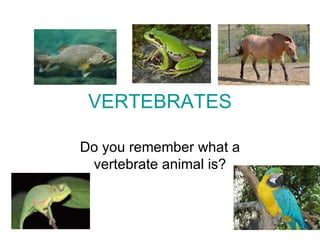
Vertebrates
- 1. VERTEBRATES Do you remember what a vertebrate animal is?
- 2. • Vertebrates are animals with a BACKBONE.
- 3. There are five types of vertebrates and they all look different from each other: • 1. Mammals • 2. Birds • 3. Reptiles • 4. Fish • 5. Amphibians
- 4. 1. MAMMALS • Mammals usually have HAIR or FUR on their bodies. • Most mammals have got four legs, also called LIMBS.
- 5. MAMMALS • They breathe with their LUNGS. • Many mammals have also got a TAIL.
- 6. MAMMALS REPRODUCTION • Female mammals give birth to live young that have developed inside their body. So mammals are VIVIPAROUS. • Female mammals have also got MAMMARY GLANDS; they produce milk to feed their young.
- 7. MAMMALS • Mammals feed on many things. Some mammals, like lions and tigers, are CARNIVORES. Other mammals, like cows and deer, are HERBIVORES. Mammals, like bears and chimpanzees, are OMNIVORES. • What is a carnivore animal? • What is a herbivore animal? • What is an omnivore animal?
- 8. MAMMALS • Now, can you think of some examples of mammals in English? • Don’t forget that WHALES, DOLPHINS, SEALS and BATS are also MAMMALS.
- 9. 2. BIRDS • Birds have got FEATHERS on their bodies. • They have got two LEGS, two WINGS and a BEAK.
- 10. BIRDS • Most birds CAN FLY. • Some birds CAN SWIM.
- 11. BIRDS • They BREATHE with their LUNGS.
- 12. BIRDS • They LAY EGGS on land. They are OVIPAROUS. • They incubate their eggs to keep them warm.
- 13. BIRDS • Now, can you think of some examples of birds in English?
- 14. 3. REPTILES • Reptiles have got HARD SCALES on their body.
- 15. REPTILES • They’ve got lungs to breathe air. • Most reptiles have four legs. • Snakes are different because they haven’t got legs. They SLITHER over the ground.
- 16. REPTILES • Most reptiles lay eggs on land. They are OVIPAROUS. • The main groups of reptiles are: LIZARDS, SNAKES, TURTLES and CROCODILES.
- 17. 4. FISH • Fish have got a long body that is covered with SCALES. • They’ve also got FINS to swim through the water.
- 18. FISH • They breathe through GILLS.
- 19. FISH • Fish are OVIPAROUS. The females produce eggs and lay them in the water.
- 20. 5. AMPHIBIANS • Most amphibians have four legs. • They have got SMOOTH SKIN.
- 21. AMPHIBIANS • They are OVIPAROUS. They lay eggs in water. • When amphibians are young, they are aquatic animals, with GILLS to breathe. Later, when they become adults, they grow LUNGS so they can breathe air and live on land.
- 22. AMPHIBIANS • The two main group of amphibians are: • 1. Frogs and toads • 2. Salamanders and newts
- 23. VERTEBRATES REVISION • Can you answer the following questions? 2. What are VERTEBRATES? 3. Which groups of vertebrates are there? 4. What can you say about each group of vertebrates? 5. Which group of animals do human beings belong to?